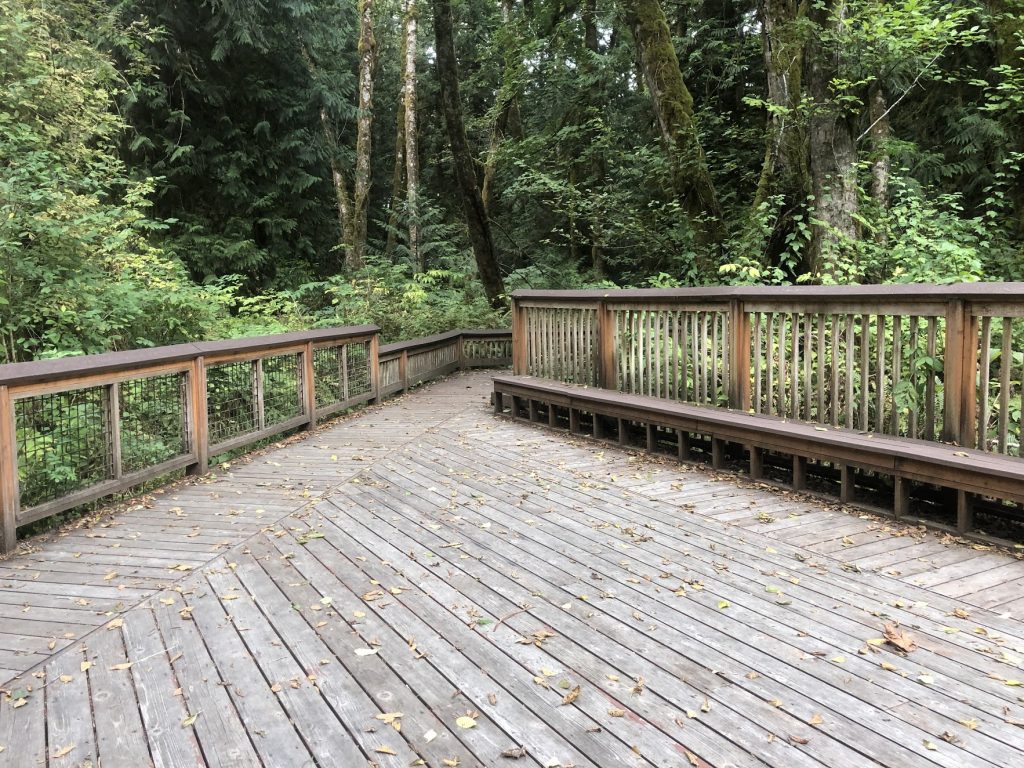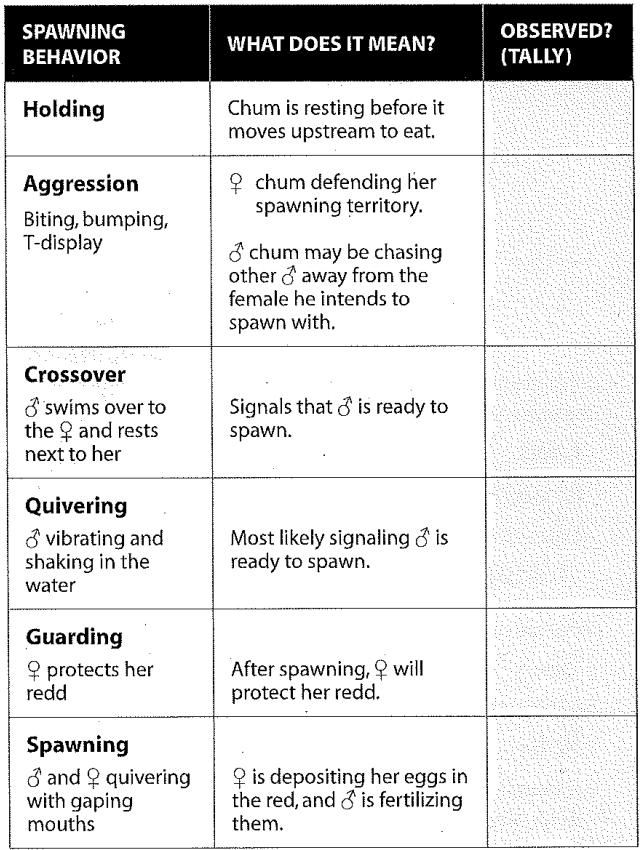Submitted by South Sound GREEN
In the face of COVID-19 and recent stay at home order, parents and guardians may find themselves looking for activities that not only keep students engaged, but also provide information about local environmental science and concerns. In our South Sound GREEN Home Based Science Project series, we will introduce and demonstrate various hands-on and at-home activities for children of all ages to do either indoors or outside!
 Today, we’re learning about salmon, just in time to see them returning to places like the McLane Creek Nature Trail!
Today, we’re learning about salmon, just in time to see them returning to places like the McLane Creek Nature Trail!
Salmon Spotting
Grade Level: 3rd-5th
Materials
- Salmon spawning behavior checklist
- A mask, if you’re going out to a local trail with other people!
Background
 November is here, and that means that chum salmon will be returning to local waterways to spawn! Every November, chum salmon that are typically 3 or 4 years old swim from the Pacific Ocean back into the Salish Sea, and find the creek or river that they were born in so that they can spawn, or lay and fertilize eggs. Along the way, their bodies need to go through major changes. For example, adult salmon need to change their bodies to go from living in saltwater environments, like the ocean, to freshwater environments, like rivers. This takes a lot of energy, and salmon need to conserve as much energy as possible to be able to swim up river and spawn. To save even more energy, salmon also stop eating once they reach estuaries, or where freshwater and saltwater meet and mix.
November is here, and that means that chum salmon will be returning to local waterways to spawn! Every November, chum salmon that are typically 3 or 4 years old swim from the Pacific Ocean back into the Salish Sea, and find the creek or river that they were born in so that they can spawn, or lay and fertilize eggs. Along the way, their bodies need to go through major changes. For example, adult salmon need to change their bodies to go from living in saltwater environments, like the ocean, to freshwater environments, like rivers. This takes a lot of energy, and salmon need to conserve as much energy as possible to be able to swim up river and spawn. To save even more energy, salmon also stop eating once they reach estuaries, or where freshwater and saltwater meet and mix.

So what do salmon need to do in order to spawn? Aside from actually swimming upstream, there are a lot of other actions that salmon need to perform, and males perform different actions than females. Here are some of the actions that we can observe in salmon, and why they do each one:
- Digging – Female uses her tail to dig her redd (or nest) in the gravel
- Aggression – Biting, bumping; female chum defend spawning territory; male chum chase off other males from the female
- Crossover – Male swims over the top of the female, most likely signaling that male is ready to spawn
- Quivering – Male vibrating and shaking in the water; signals that male is ready to spawn
- Gaping/Spawning – Male/female quivering and gaping mouths; female is depositing her eggs in the redd and male is fertilizing them
- Guarding – Female protects her redd (or nest) after spawning
If you want to see what these all actually look like, check out this video from the South Puget Sound Salmon Enhancement Group!
While all of this is happening, it is very important that salmon are not disturbed by humans. Salmon are already putting all of their energy towards spawning behaviors, and hearing loud noises or seeing large shadows may force them to seek shelter and waste valuable energy. If you want to observe salmon spawning this fall, head to a spot like the McLane Creek Nature Trail where you can see salmon at a safe distance from their viewing platforms. Make sure you move slowly and only speak in whispers to keep your noise levels down. You’ll be treated to an amazing sight of salmon! As you watch, see if you can identify all of the different salmon spawning behaviors using our activity below!

Procedure
- For this activity, you’ll need to print out this salmon spawning behavior checklist (you can also find the checklist here).

- Head out to a local waterway this month. Certain waterways may not be able to host salmon, so unless you know for sure that your site will have salmon, we recommend going out to McLane Creek Nature Trail or Kennedy Creek Salmon Trail, which will have good viewing platforms and information posted along the trail.
- Remember to consider your actions when you approach a creek or river that may have salmon. Move slowly and keep quiet in order to not scare away any salmon.
- If you see salmon, try to identify males and females. Males are typically larger, have a hump on their back, and have vertical dark stripes. Females are typically smaller and have a long dark horizontal band on their sides.
- Once you can figure out which are males and females, it should be easier to identify different behaviors! Add a checkmark to your checklist any time you see a specific behavior.
- If you don’t see certain behaviors, try to come back a week or two later. You may also notice a change in the amount of salmon (and salmon carcasses)!
- Tip – wear polarized glasses (if you have them!) to make it easier to see salmon spawning. Polarized lenses will help reduce glare from the water.
Vocabulary
- Estuary: Where a freshwater body and a saltwater body meets and mixes.
- Spawn: To deposit and fertilize eggs.
Keep Learning!
- Learn more about the salmon life cycle with our previous Salmon Obstacle Course activity!
- Learn more about McLane Creek Nature Trail and salmon with the Thurston County StreamTeam! South Sound GREEN will be hosting virtual field trips with StreamTeam this month – check our website for updates!
- Find more information about salmon spawning behaviors and learn about nearby salmon spot Kennedy Creek with the South Puget Sound Salmon Enhancement Group.
- Share any salmon pictures with us on Instagram! Use the hashtag #GREENfromhome or find us at @southsoundgreen.
South Sound GREEN (Global Rivers Environmental Education Network) is a watershed education program in Thurston County that educates, empowers and connects thousands of local students in watershed studies annually. Through South Sound GREEN, participants engage in science and engineering practices related to water quality in South Sound. For more information, visit the South Sound Green website.



















































